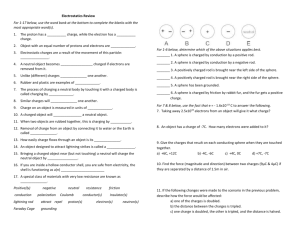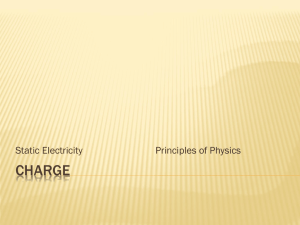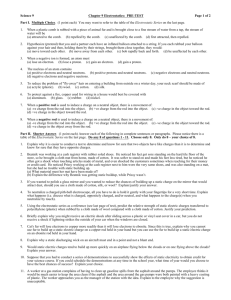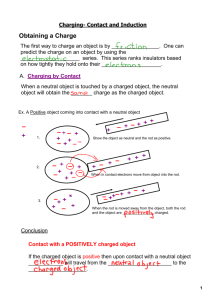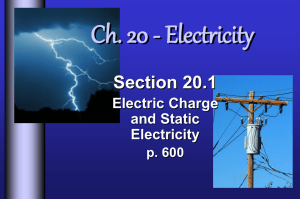Sci 9 Review Worksheet 7.2 Electric Force With
advertisement
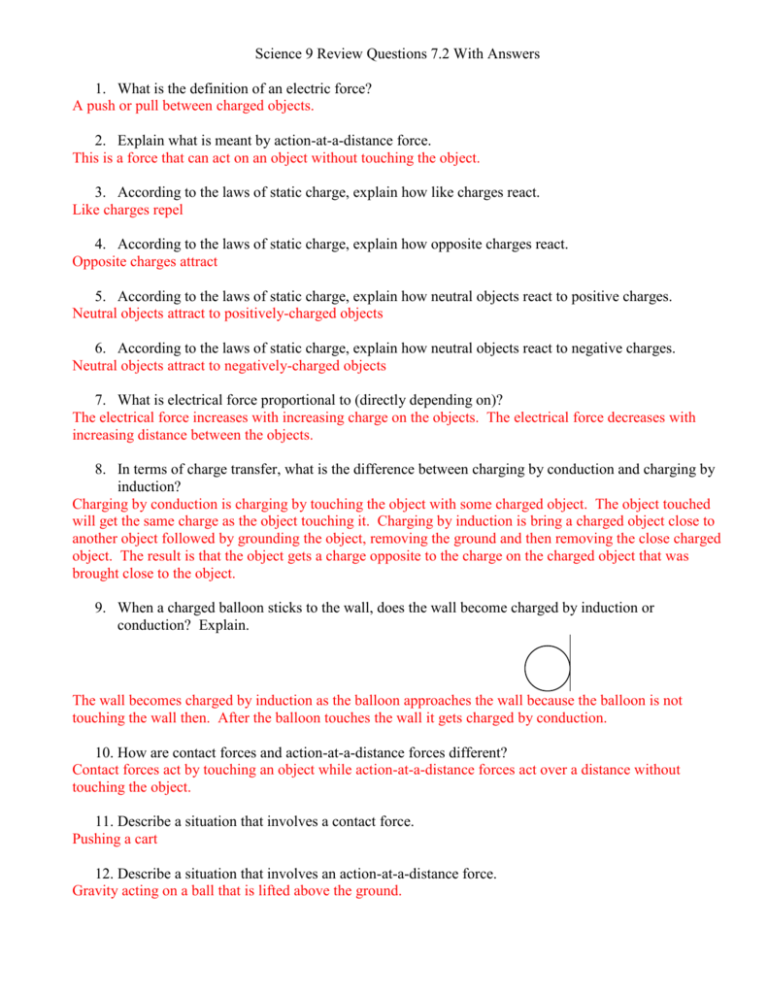
Science 9 Review Questions 7.2 With Answers 1. What is the definition of an electric force? A push or pull between charged objects. 2. Explain what is meant by action-at-a-distance force. This is a force that can act on an object without touching the object. 3. According to the laws of static charge, explain how like charges react. Like charges repel 4. According to the laws of static charge, explain how opposite charges react. Opposite charges attract 5. According to the laws of static charge, explain how neutral objects react to positive charges. Neutral objects attract to positively-charged objects 6. According to the laws of static charge, explain how neutral objects react to negative charges. Neutral objects attract to negatively-charged objects 7. What is electrical force proportional to (directly depending on)? The electrical force increases with increasing charge on the objects. The electrical force decreases with increasing distance between the objects. 8. In terms of charge transfer, what is the difference between charging by conduction and charging by induction? Charging by conduction is charging by touching the object with some charged object. The object touched will get the same charge as the object touching it. Charging by induction is bring a charged object close to another object followed by grounding the object, removing the ground and then removing the close charged object. The result is that the object gets a charge opposite to the charge on the charged object that was brought close to the object. 9. When a charged balloon sticks to the wall, does the wall become charged by induction or conduction? Explain. The wall becomes charged by induction as the balloon approaches the wall because the balloon is not touching the wall then. After the balloon touches the wall it gets charged by conduction. 10. How are contact forces and action-at-a-distance forces different? Contact forces act by touching an object while action-at-a-distance forces act over a distance without touching the object. 11. Describe a situation that involves a contact force. Pushing a cart 12. Describe a situation that involves an action-at-a-distance force. Gravity acting on a ball that is lifted above the ground. Science 9 Review Questions 7.2 With Answers 13. State the three laws of static charge. Like charges repel, opposite charges attract and neutral objects attract to either positive or negative charges. 14. A positively charged object is brought near another object. If the two objects repel, what is the charge on the second object? The second object has the same charge as the first object. 15. A charge is transferred from one conductor to another by touching. What kind of charging process is this? Charging by conduction 16. A charge is relocated within a conductor because there is a charged object nearby. What kind of charging process is this? Charging by induction (without touching the object with the charged object). 17. A positively charged object is brought near a second object. The two objects attract. Does this observation prove that the second object must be negatively charged? Explain. The second object could be either neutral or negative. 18. An unknown material is rubbed with silk and becomes charged. Explain how you could use a negative acetate strip or a positive glass rod to determine the type of charge on the unknown material. Both the negative acetate and the positive glass rod would be brought near the object and whichever object repelled the unknown material, that would be the charge on the material. (Ex: if the glass rod repelled the object, the object would be positive like the glass rod.) 19. Suppose you are handed an electroscope that another student just used. You observe that the leaves are already spread apart. You now slowly bring a positive glass rod near the knob of the electroscope and the leaves begin to get closer together. Why did the leaves move closer together when you brought the glass rod near the knob of the electroscope? Because the leaves dropped, the charge on the electroscope must have been negative (opposite to the rod’s charge). The electrons in the leaves of the electroscope would move upward (attracted to the glass rod) which would leave the leaves neutral and they would fall straight. 20. State the similarities and differences between charging by conduction and charging by induction. Both methods leave objects charged but with opposite charges. A negative object touching (conduction) an object makes the object negative. But a negative object brought near to a grounded object and then the ground is removed, will be positive in charge. 21. State the relationship of the distance between two charged objects and the force between them. The greater the distance the less the force between them. 22. Use your understanding of static charge to explain how plastic wrap clings to a neutral glass bowl. Plastic cling has a negative charge. When it approaches a glass bowl, it repels electrons to the inside of the glass bowl so that the outside of the bowl is overall positive which attracts the cling wrap to itself. Science 9 Review Questions 7.2 With Answers 23. A positively charged object is positioned near one end of a neutral metal rod that is supported by an insulator. If you briefly touch the opposite end of the metal rod with your finger, it becomes negatively charged. Explain how the metal rod became charged without being touched by the charged object. The positive object (round) attracted the electrons towards itself. This left the finger end of the rod positive in charge. When the finger touched the rod, it grounded the rod and allowed electrons to enter or leave the rod. Since the finger end of the rod is positive, it attacts electrons into the rod, making the rod negative in charge overall.
